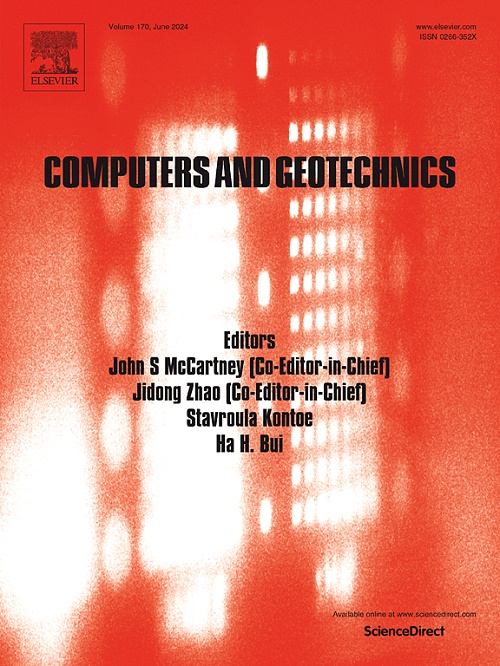Mineral grain-texture model and impact on microcracking and mechanical response of granite
IF 5.3
1区 工程技术
Q1 COMPUTER SCIENCE, INTERDISCIPLINARY APPLICATIONS
引用次数: 0
Abstract
Granites are representative of generic crystalline rocks characterized by their complex crystal-grain structure. Variations in the composition, size, shape and orientation of mineral grains result in pronounced heterogeneity and anisotropy at the microscopic scale, significantly influencing mechanical properties as well as the initiation and propagation of microcracks. A grain-texture model (GTM) is used to characterize the microstructural features of porphyritic monzogranite, based on the “templated” − “grain growth” method. This addresses the limitations inherent in Grain-Based Models (GBM) that do not allow for modifications to mineral grain shapes. The accuracy of this novel model was validated through comparisons between numerical and experimental results. Subsequent validations were against granite models with varying biotite contents to examine related mechanical and microcracking response as a result of component mineral properties, shape and orientation. Changes in biotite content influence heterogeneity and consequently both mechanical properties and failure characteristics of the composite granites. As biotite strength decreases, there is an increased likelihood for cracks to initiate and propagate within it; correspondingly, the decrease in stiffness of the biotite has a notable impact on the pattern and path of crack propagation. Alteration in the shape and orientation of mineral grains results in significant changes in the anisotropy of granite through impact on the number and arrangement of grain boundary contacts. When these boundary contact orientations align with fracture directions, rocks exhibit an increased propensity for the evolution of throughgoing fractures and macroscale failure.
矿物颗粒结构模型及其对花岗岩微裂纹和力学响应的影响
花岗岩以其复杂的晶粒结构为特征,是一类典型的结晶岩。矿物颗粒的组成、大小、形状和取向的变化导致微观尺度上明显的非均质性和各向异性,显著影响力学性能以及微裂纹的萌生和扩展。基于“模板”-“晶粒生长”方法,采用颗粒织构模型(GTM)表征了斑状二长花岗岩的微观结构特征。这解决了基于颗粒的模型(GBM)不允许修改矿物颗粒形状的固有局限性。通过数值与实验结果的比较,验证了该模型的准确性。随后的验证是针对具有不同黑云母含量的花岗岩模型,以检查由于成分矿物性质,形状和方向而产生的相关机械和微裂纹响应。黑云母含量的变化会影响复合花岗岩的非均质性,从而影响复合花岗岩的力学性能和破坏特征。随着黑云母强度的降低,裂缝在黑云母内部萌生和扩展的可能性增加;相应地,黑云母刚度的降低对裂纹扩展模式和路径有显著影响。矿物颗粒形状和取向的改变通过影响晶界接触的数量和排列,导致花岗岩各向异性的显著变化。当这些边界接触方向与裂缝方向一致时,岩石表现出更大的贯通裂缝演化倾向和宏观破坏倾向。
本文章由计算机程序翻译,如有差异,请以英文原文为准。
求助全文
约1分钟内获得全文
求助全文
来源期刊

Computers and Geotechnics
地学-地球科学综合
CiteScore
9.10
自引率
15.10%
发文量
438
审稿时长
45 days
期刊介绍:
The use of computers is firmly established in geotechnical engineering and continues to grow rapidly in both engineering practice and academe. The development of advanced numerical techniques and constitutive modeling, in conjunction with rapid developments in computer hardware, enables problems to be tackled that were unthinkable even a few years ago. Computers and Geotechnics provides an up-to-date reference for engineers and researchers engaged in computer aided analysis and research in geotechnical engineering. The journal is intended for an expeditious dissemination of advanced computer applications across a broad range of geotechnical topics. Contributions on advances in numerical algorithms, computer implementation of new constitutive models and probabilistic methods are especially encouraged.
 求助内容:
求助内容: 应助结果提醒方式:
应助结果提醒方式:


